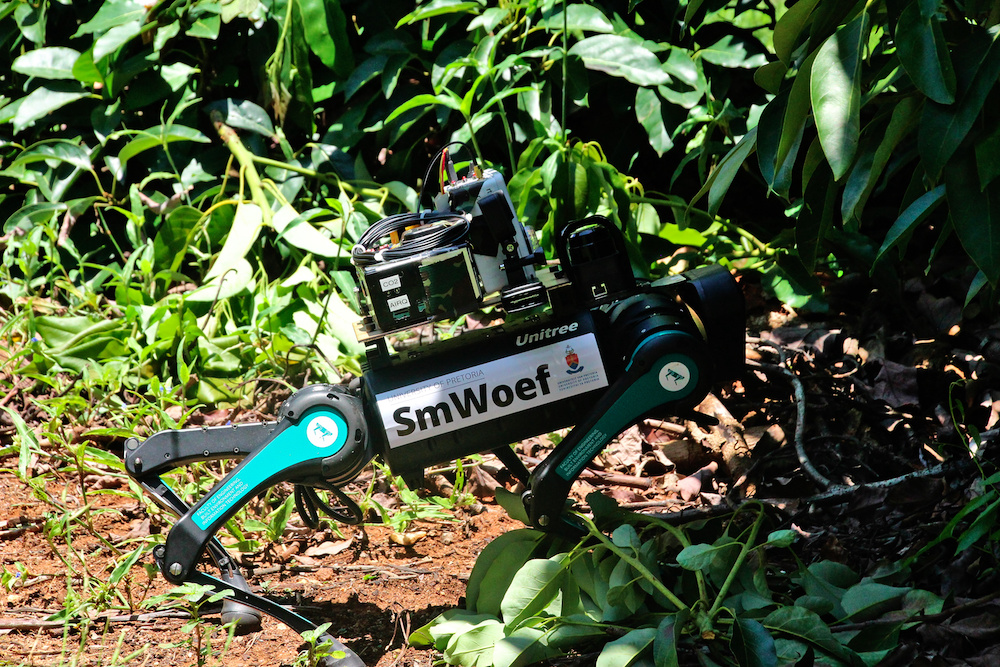“The sky’s the limit. It’s almost like ‘What do you think you can use it for?’ We’re enjoying throwing around ideas and coming up with even more exciting ways that smWoef can change the way we do things,” Broekman said.
Pretoria, South Africa (09 September 2022) – It can dance. It can sniff. It does a backflip with ease. And it’s a bit of a show-off, only too happy to be one of the University of Pretoria’s (UP’s) greatest pride and joys, whether prancing around an avocado orchard or accompanying the Vice-Chancellor and Principal, Professor Tawana Kupe, when he entertains VIPs.
It is smWoef, the University’s new robot dog, a 12kg Unitree A1 that stands less than half a metre tall.
But it is not UP’s only robot.
Libby, a robotic library assistant, has been working at the Merensky Library on UP’s Hatfield Campus since 2019. And Stevie the robot started in the intensive-care unit (ICU) at the Steve Biko Academic Hospital in July 2021. Stevie sets the scene for telemedicine – ICU teams in Germany not only attend ward rounds in Pretoria virtually but can also interact via Stevie’s phone.
Professor Wynand Steyn, Head of the Department of Civil Engineering in UP’s Faculty of Engineering, Built Environment and Information Technology, was the one who named smWoef. The “sm” stands for “smart” because it is a Smart Alternative Transportation Platform connected to the internet, and “woef” is the Afrikaans spelling for “woof”, the sound a dog makes, because smWoef is a four-legged robot that resembles a dog. Despite the formulation of its name, however, it is pronounced as one syllable – as if it were written as “smwoef”.
smWoef arrived at UP from China last year without its lithium-ion battery pack, which had to be shipped separately because it is hazardous. Because of the COVID-19 pandemic the battery was stuck in Hong Kong for months. However, the enterprising researchers at UP’s Engineering 4.0 facility – which focuses on research on smart transport, cities and infrastructure – made a plan.
Andre Broekman, who was in the final year of his PhD in railway engineering, said, “We got it tethered to an electrical cable, so it looked like it was on a leash. But eventually, earlier this year, we got the batteries and controller and then it could start walking about and doing its thing. So it’s still a puppy. It’s still undergoing its training courses. And we’re keeping it busy.”
A dark green robot dog called smWoef, who is a 12kg Unitree A1, stands in green grass among bushes.
The “sm” stands for “smart” because it is a Smart Alternative Transportation Platform connected to the internet, and “woef” is the Afrikaans spelling for “woof”, the sound a dog makes, because smWoef is a four-legged robot that resembles a dog.

Most of its day-to-day workings fall on Jordan Mostert, a civil engineering technologist who, quite by chance, landed at UP for his two-year internship with the Department of Science and Innovation.
“When smWoef came, I’m the one who figured out his applications and how exactly he works. It’s a once-in-a-lifetime opportunity for me,” Mostert said. “At the moment it’s a big learning tool for us in terms of programming, in terms of data collection, in terms of what type of applications he can be used for. We’re basically finding out what kind of terrains and what type of environments he can handle. Once we have a solid proof of concept we can apply it to different scenarios and get data.”
Mostert also developed a little mounting platform with a GoPro camera and a Wi-Fi sensor for smWoef to enable communications in various environments.
One of the highlights of these trials was smWoef’s visit to ZZ2’s headquarters in Mooketsi, Limpopo, where it navigated between avocado trees to test its ability to collect data for the generation of a future digital copy of the surroundings.
They went there because it had been suggested that smWoef could be used in orchards to count fruit and take air quality measurements.
“It’s an ideal candidate for that because it can do it continuously and track changes over time,” Broekman said. He added that the agriculture industry is “very pro-technology” in terms of logging data, measuring parameters, making improvements, and being more profitable. “They understand the value-added functionality of technology. They’re also very excited about the potential of where we’re going.”
So too are Broekman, Mostert and other UP researchers.
“As a research institution, we are showing these proofs of concepts, we’re developing this cutting-edge technology. Even though the applications are not at a commercial level yet, we’re showing what is possible, and coming up with these novel ideas,” Broekman said.
smWoef, which cost about US$15 000 (R250 000), weighs about 12kg. It has four motors that allow it to move at up to 4.4km/h. It can operate at up to 8m by remote control or be programmed for longer distances. Its modular shape allows it to carry equipment weighing up to 5kg, such as a super-fast laser LiDAR (light detection and ranging) scanner. It has ports on its back for inputting Internet of Things (IOT) devices such as temperature sensors and an artificial nose.
“It’s a computer on feet,” Broekman said.
Being able to gauge temperature means it can, for example, monitor greenhouses for optimum growth of seedlings, and test industrial cooling systems.
Being able to smell means it can operate like a sniffer dog because they can programme it to analyse and track a smell.
Being able to traverse difficult-to-access terrains, and do so without leaving DNA like humans would means it can collect data from scenes without contaminating them.
“The sky’s the limit. It’s almost like ‘What do you think you can use it for?’ We’re enjoying throwing around ideas and coming up with even more exciting ways that smWoef can change the way we do things,” Broekman said.

